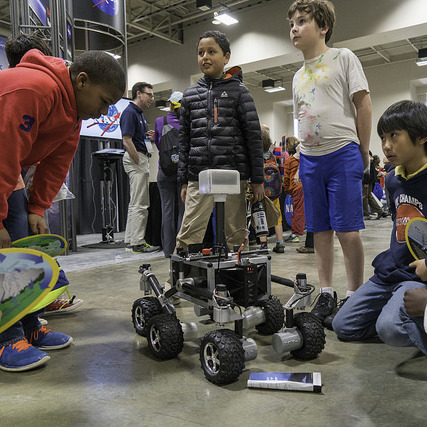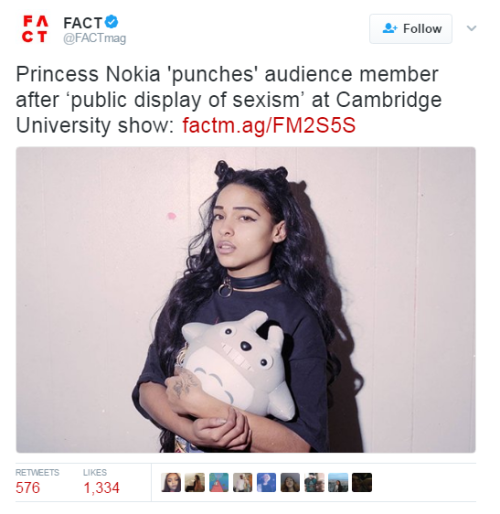undeadratmother-blog
Name's Undead/Rat. I love my Hubby, Cat and 6 Rats. I like the colors Maroon and Purple. My favorite genres are Horror, Fantasy, Mystery and Action. And Someday I hope to be a Cosmetic Chemist and Forensic Pathologist. I also love games, role playing and eating.
10 posts
Latest Posts by undeadratmother-blog
(via https://www.youtube.com/watch?v=5wosC9QLQTM)
Five NASA Technologies at the 2017 Consumer Electronics Show
This week, we’re attending the International Consumer Electronics Show (CES), where we’re joining industrial pioneers and business leaders from across the globe to showcase our space technology. Since 1967, CES has been the place to be for next-generation innovations to get their marketplace debut.
Our technologies are driving exploration and enabling the agency’s bold new missions to extend the human presence beyond the moon, to an asteroid, to Mars and beyond. Here’s a look at five technologies we’re showing off at #CES2017:
1. IDEAS
Our Integrated Display and Environmental Awareness System (IDEAS) is an interactive optical computer that works for smart glasses. The idea behind IDEAS is to enhance real-time operations by providing augmented reality data to field engineers here on Earth and in space.

This device would allow users to see and modify critical information on a transparent, interactive display without taking their eyes or hands off the work in front of them.

This wearable technology could dramatically improve the user’s situational awareness, thus improving safety and efficiency.

For example, an astronaut could see health data, oxygen levels or even environmental emergencies like “invisible” ethanol fires right on their helmet view pane.

And while the IDEAS prototype is an innovative solution to the challenges of in-space missions, it won’t just benefit astronauts—this technology can be applied to countless fields here on Earth.
2. VERVE
Engineers at our Ames Research Center are developing robots to work as teammates with humans.

They created a user interface called the Visual Environment for Remote Virtual Exploration (VERVE) that allows researchers to see from a robot’s perspective.

Using VERVE, astronauts on the International Space Station remotely operated the K10 rover—designed to act as a scout during NASA missions to survey terrain and collect science data to help human explorers.

This week, Nissan announced that a version of our VERVE was modified for its Seamless Autonomous Mobility (SAM), a platform for the integration of autonomous vehicles into our society. For more on this partnership: https://www.nasa.gov/ames/nisv-podcast-Terry-Fong
3. OnSight
Did you know that we are leveraging technology from virtual and augmented reality apps to help scientists study Mars and to help astronauts in space?

The Ops Lab at our Jet Propulsion Laboratory is at the forefront of deploying these groundbreaking applications to multiple missions.

One project we’re demonstrating at CES, is how our OnSight tool—a mixed reality application developed for the Microsoft HoloLens—enables scientists to “work on Mars” together from their offices.

Supported by the Mars 2020 and Curiosity missions, it is currently in use by a pilot group of scientists for rover operations. Another HoloLens project is being used aboard the International Space Station to empower the crew with assistance when and where they need it.

At CES, we’re also using the Oculus Rift virtual reality platform to provide a tour from the launchpad at our Kennedy Space Center of our Space Launch System (SLS). SLS will be the world’s most powerful rocket and will launch astronauts in the Orion Spacecraft on missions to an asteroid and eventually to Mars. Engineers continue to make progress aimed toward delivering the first SLS rocket to Kennedy in 2018.
4. PUFFER
The Pop-Up Flat Folding Explorer Robot, PUFFER, is an origami-inspired robotic technology prototype that folds into the size of a smartphone.

It is a low-volume, low-cost enhancement whose compact design means that many little robots could be packed in to a larger “parent” spacecraft to be deployed on a planet’s surface to increase surface mobility. It’s like a Mars rover Mini-Me!

5. ROV-E
Our Remote Operated Vehicle for Education, or ROV-E, is a six-wheeled rover modeled after our Curiosity and the future Mars 2020 Rover.

It uses off-the-shelf, easily programmable computers and 3D-printed parts. ROV-E has four modes, including user-controlled driving to sensor-based hazard-avoidance and “follow me” modes. ROV-E can answer questions about Mars and follow voice commands.

ROV-E was developed by a team of interns and young, up-and-coming professionals at NASA’s Jet Propulsion Laboratory who wanted to build a Mars rover from scratch to help introduce students and the public to Science, Technology, Engineering & Mathematics (STEM) careers, planetary science and our Journey to Mars.
Make sure to follow us on Tumblr for your regular dose of space: http://nasa.tumblr.com
Deserved


My girl!
12 days into the new year, 353 to go
Maybe you made a New Year’s resolution, maybe you didn’t. Either way, you probably deserve to feel happy and encouraged in this new year. Consider adding a hearty dose of encouraging, kind animals to your dashboard.
Badly Drawn Everything (@badlydrawneverything)
Reportedly features badly drawn things, yet this bee is not bad at all. This bee’s message is both positive and realistic. Cool.

Toria (@toriascribblingalonewithcomics)
This Tumblr has a whole tag dedicated to motivational animals. Listen to this sloth. Don’t you dare hurt their feelings.

The Latest Kate (@thelatestkate)
Even more positive Animalia. Maybe it’s an otter. It’s at least a cousin of the otter. Maybe it’s a polecat? Could be a ferret. Let’s not get caught up on the details, let’s just enjoy this long mammal.

13 Reasons to Have an Out of This World Friday (the 13th)
1. Know that not all of humanity is bound to the ground

Since 2000, the International Space Station has been continuously occupied by humans. There, crew members live and work while conducting important research that benefits life on Earth and will even help us eventually travel to deep space destinations, like Mars.
2. Smart people are up all night working in control rooms all over NASA to ensure that data keeps flowing from our satellites and spacecraft

Our satellites and spacecraft help scientists study Earth and space. Missions looking toward Earth provide information about clouds, oceans, land and ice. They also measure gases in the atmosphere, such as ozone and carbon dioxide, and the amount of energy that Earth absorbs and emits. And satellites monitor wildfires, volcanoes and their smoke.

Satellites and spacecraft that face toward space have a variety of jobs. Some watch for dangerous rays coming from the sun. Others explore asteroids and comets, the history of stars, and the origin of planets. Some fly near or orbit other planets. These spacecraft may look for evidence of water on Mars or capture close-up pictures of Saturn’s rings.
3. The spacecraft, rockets and systems developed to send astronauts to low-Earth orbit as part our Commercial Crew Program is also helping us get to Mars
Changes to the human body during long-duration spaceflight are significant challenges to solve ahead of a mission to Mars and back. The space station allows us to perform long duration missions without leaving Earth’s orbit.

Although they are orbiting Earth, space station astronauts spend months at a time in near-zero gravity, which allows scientists to study several physiological changes and test potential solutions. The more time they spend in space, the more helpful the station crew members can be to those on Earth assembling the plans to go to Mars.
4. Two new science missions will travel where no spacecraft has gone before…a Jupiter Trojan asteroid and a giant metal asteroid!

We’ve selected two missions that have the potential to open new windows on one of the earliest eras in the history of our solar system – a time less than 10 million years after the birth of our sun!

The first mission, Lucy, will visit six of Jupiter’s mysterious Trojan asteroids. The Trojans are thought to be relics of a much earlier era in the history of the solar system, and may have formed far beyond Jupiter’s current orbit.

The second mission, Psyche, will study a unique metal asteroid that’s never been visited before. This giant metal asteroid, known as 16 Psyche, is about three times farther away from the sun than is the Earth. Scientists wonder whether Psyche could be an exposed core of an early planet that could have been as large as Mars, but which lost its rocky outer layers due to a number of violent collisions billions of years ago.
5. Even astronauts eat their VEGGIES’s
NASA astronaut Shane Kimbrough collected the third and final harvest of the latest round of the Veggie investigation, testing the capability to grow fresh vegetables on the International Space Station.

Understanding how plants respond to microgravity is an important step for future long-duration space missions, which will require crew members to grow their own food. Crew members have previously grown lettuce and flowers in the Veggie facility. This new series of the study expands on previous validation tests.
6. When you feel far away from home, you can think of the New Horizons spacecraft as it heads toward the Kuiper Belt, and the Voyager spacecrafts are beyond the influence of our sun…billions of miles away

Our New Horizons spacecraft completed its Pluto flyby in July 2015 and has continued on its way toward the Kuiper Belt. The spacecraft continues to send back important data as it travels toward deeper space at more than 32,000 miles per hour, and is nearly 3.2 billion miles from Earth.

In addition to New Horizons, our twin Voyager 1 and 2 spacecraft are exploring where nothing from Earth has flown before. Continuing on their more-than-37-year journey since their 1977 launches, they are each much farther away from Earth and the sun than Pluto. In August 2012, Voyager 1 made the historic entry into interstellar space, the region between the stars, filled with material ejected by the death of nearby stars millions of years ago.
7. Earth has a magnetic field that largely protects it from the solar wind stripping away out atmosphere…unlike Mars

Findings from our MAVEN mission have identified the process that appears to have played a key role in the transition of the Martian climate from an early, warm and wet environment to the cold, arid planet Mars is today. MAVEN data have enabled researchers to determine the rate at which the Martian atmosphere currently is losing gas to space via stripping by the solar wind. Luckily, Earth has a magnetic field that largely protects it from this process.
8. There are humans brave enough to not only travel in space, but venture outside space station to perform important repairs and updates during spacewalks

Spacewalks are important events where crew members repair, maintain and upgrade parts of the International Space Station. These activities can also be referred to as EVAs – Extravehicular Activities. Not only do spacewalks require an enormous amount of work to prepare for, but they are physically demanding on the astronauts. They are working in the vacuum of space in only their spacewalking suit.

When on a spacewalk, astronauts use safety tethers to stay close to their spacecraft. One end of the tether is hooked to the spacewalker, while the other end is connected to the vehicle. Spacewalks typically last around 6.5 hours, but can be extended to 7 or 8 hours, if necessary.
9. We’re working to create new aircraft that will dramatically reduce fuel use, emissions and noise…meaning we could change the way you fly!

The nation’s airlines could realize more than $250 billion dollars in savings in the near future thanks to green-related technologies that we are developing and refining. These new technologies could cut airline fuel use in half, pollution by 75% and noise to nearly one-eighth of today’s levels!
10. You can see a global image of your home planet…EVERY DAY

Once a day, we will post at least a dozen new color images of Earth acquired from 12 to 36 hours earlier. These images are taken by our EPIC camera from one million miles away on the Deep Space Climate Observatory (DSCOVR). Take a look HERE.
11. Employees of NASA have always been a mission driven bunch, who try to find answers that were previously unknown
The film “Hidden Figures,” focuses on the stories of Katherine Johnson, Mary Jackson and Dorothy Vaughan, African-American women who were essential to the success of early spaceflight.
Today, we embrace their legacy and strive to include everyone who wants to participate in our ongoing exploration. In the 1960’s, we were on an ambitious journey to the moon, and the human computers portrayed in Hidden Figures helped get us there. Today, we are on an even more ambitious journey to Mars. We are building a vibrant, innovative workforce that reflects a vast diversity of discipline and thought, embracing and nurturing all the talent we have available, regardless of gender, race or other protected status. Take a look at our Modern Figures HERE.
12. A lot of NASA-developed tech has been transferred for use to the public
Our Technology Transfer Program highlights technologies that were originally designed for our mission needs, but have since been introduced to the public market. HERE are a few spinoff technologies that you might not know about.
13. If all else fails, here’s an image of what we (Earth) and the moon look like from Mars

From the most powerful telescope orbiting Mars comes a new view of Earth and its moon, showing continent-size detail on the planet and the relative size of the moon. The image combines two separate exposures taken on Nov. 20 by our High Resolution Imaging Science Experiment (HiRISE) camera on our Mars Reconnaissance Orbiter.
In the image, the reddish feature near the middle of the face of Earth is Australia.
HE IS REPLACING IT YOU TWATS THE FACT I HAVE INSURANCE AND PAY ALMOST 900$ A FUCKING MON \TH IS BECAUSE OF THIS FUCKING ACT. ITS GOOD FOR LAZY FUCKERS WHO DONT WANT TO PAY FOR INSURANCE BUT FOR PEOPLE THAT DO (WHICH IS 85% OF THE US) HAVE INSURANCE GET FUCKED FOR WORKING AND PAYING FOR OURSELVES. FUCK YOU

The Affordable Care Act has been law of the land for years and it’s helped millions of folks — like the 55 million women who have access to no-copay birth control. But the law is under attack. This week’s Issue Time is led by two Planned Parenthood ACA experts who are here to answer your questions about everything from signing up, to fighting back against repeal:
Kaissa Denis, MPP is responsible for running the day to day operations of our ACA work at Planned Parenthood Federation of America. Before she began her ACA work, she was a seasoned community organizer focused on organizing diaspora communities.
Jamille Fields, JD/MPH is a Policy Analyst at Planned Parenthood Federation of America. Her work is focused on ensuring health care reform improves reproductive health care access for low-income people, women, and young people across the country.
The Planned Parenthood ask box is open.
Send in your stories, questions, concerns — anything! We’ll start responding on Sunday, January 29th.

What if white people did this.
Black excellence means luxuriating in your Blackness. Just bathing in it. In a world that has told you forever that it’s not ok to be Black and you’re like “No, yes it is. I’m going to be Black as possible. And crush it while doing so.”
Here’s Tracy Clayton and Heben Nigatu from Buzzfeed’s “Another Round” on what Black excellence means to them.
Thought some of you would like to see this.